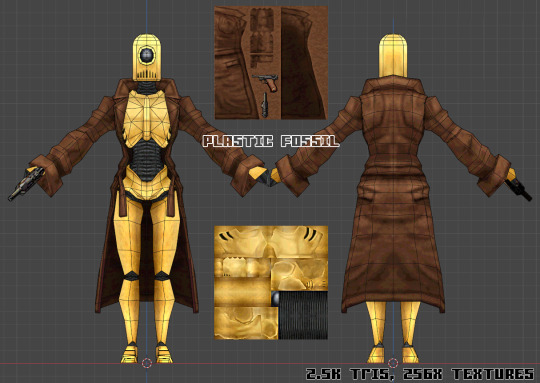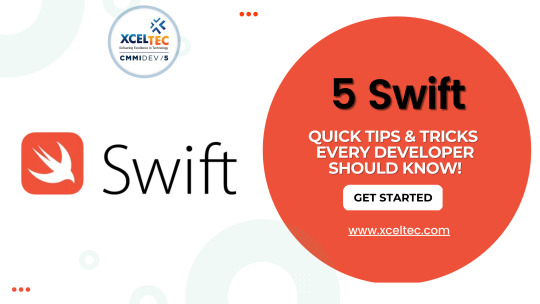#Refactoring Travel
Explore tagged Tumblr posts
Audio
Title: What a Hyped Beautiful World Artist: t+pazolite Album: リファクタリング・トラベル -Refactoring Travel- (2019)
0 notes
Text


THORNTON GREY, 2.5K TRIS & 256x TEX
Worldbuilding and cg autism under the cut
This is Thornton Grey, a character of mine I've had for around 15 years now. He's from a more or less retired worldbuilding universe of mine, waiting to be either recycled or refactored. Thornton is one of the dearest characters from that setting (and in all honesty, one of my dearest characters in general) and I tend to keep him in my current brain palette of little men to doodle in various formats.
I've been doing these early cd-3d (aka psx /ps1 etc) styled models for some of my OCs with hopes of eventually ?? learning godot. I guess. I need to get my worldbuilding out to the world so it become property of the grand creative consciousness, aka to affect people with my art the same way people affected me.
The tri count is higher than many people tend to target for this style and i'll probably improve that over time as I make various kinds of assets related to my worldbuilding, but eh who cares lol. The textures are photobashed stock images with details painted over and posterized in photoshop.
Here's some bonus 'march of progress' of my art of him over time.

Lore? Well, many of my characters start out with me being bored or annoyed by a specific trope in media, and he is no exception. He's a few things, but primarily he's my take on the 'little pinocchio robot boy/man who wishes he was a Real human'. Thornton's character addresses more so the preoccupations we as humans have to classify and categories types of people or non-people.
The universe, with the codename Redverse, is set approximately 1920s/1930s alt-earth america. He was child to a pair of grandmaster clocksmiths in the early 1800s whom could not have children of their own, and spent decades producing an analog AI composed of millions of intricate gears assembled with a small cube which composes his brain. He has a small boiler in his trunk that provides power for the various hydraulic systems within his limbs and keeps his brain's clockwork properly wound.
After caring for his elderly parents until their deaths, he took his father's trenchcoat and gun and traveled the country. (why is his gun a german luger? i don't know, i was like 17. it looks cool.)

Computers, robots, ai, etc, are not really a thing in this universe, granted the targeted vague time period. So he's generally regarded by others as an advanced automaton (he basically is.) and as a curiosity. He however has no qualms about being artificial in nature, as he sees it, he has all the makings of the average man -- has parents, has to eat (hard coal for his boiler), and can love. To view him as nonhuman baffles him, and his matter of fact attitude about the issue tends to win over many people he gets to know. Regarded mostly with respect for his kind and empathetic nature within the communities he spends any amount of time in, he's eventually pulled into the underworld of armed resistance forming against the increasing power of a fascist authoritarian regime that has quickly possessed control of the tumultuous american politics.
A tl;dr of this universe is "but what if AMERICA was the nazis". Very clever 17yo me. I'm sure you had a shock of your life when you grew up and learned about america's rancid role in world politics. Thus the retirement and possible refactoring -- I think it can be a compelling alt history universe if I actually learn more about how do to it properly, if i ever revive it. I'm not the first person to do it but maybe I can offer something interesting if at least for the setting of a noir style vibe game.
Anyway, Thornton becomes very involved. So involved, in fact, he becomes essentially the poster child of the resistance movement. And is targeted for it.
Widely hailed as a martyr for his subsequent demise, the resistance movement gets his hands on his thankfully intact head and revive him the best they can. He is unfortunately damaged, and upon revival, starts channeling visions from beyond.

And that is about as far as I got with his story. Perhaps you will see more of him in the future.
#worldbuilding#psx#low poly#3d art#3d artwork#3d model#blender#original character#artists on tumblr#robot#steampunk#noir#ps1 aesthetic#my work
22 notes
·
View notes
Text


[IDs in alt text.]
Refactoringtravelstylia: a tekkor (link) relating to the album Refactoring Travel by t+pazolite.
tagging @dragonpride17 @radiomogai @musicamogai
#refactoringtravelstylia#hardkoria#gender label#gender coining#mogai coining#the fox coins#eyestrain
10 notes
·
View notes
Text
Starting out on Godot: Part Two, Tower Defence
Tower Defence. Tower Defense. We love different spellings.
For this part I needed a way to communicate between components, or nodes, to enable loading from one mode to another. I have a hub (see previous post), now I need to get from there to my level with a tower defence.
To do this I had to implement the signal system so my root node, the game manager, can unload the hub area and load in the Tower Defence area.


My implementation here is pretty clunky and could be refactored easily. But at least it worked. And now I can move from here:

to here:

Now the above screen is actually jumping ahead a little bit, but that's fine. I made a very basic level scene in Blender by using the shape tool to score grooves into a plane - that's the path - and made some trees and rocks with primitive shapes to make some fauna. I also made some hexagonal plinths to place defenders on. I kept it very basic and simple for now as this was for prototyping.
Once I had a system to change scenes and update cameras I could work on implementing the basics of a Tower Defence. The most standard components are 1) Enemies, 2) A path for enemies to travel, 3) Defenders and 4) An area for defenders to be placed.
Godot has me covered here, and strangely enough to implement the mechanics of the path there is whole ready made node structure for it. The Path node, and the Path Follow node:

The path nodes let me set up the nodes that the enemies will walk along, and the path follow node lets me attach the enemy units to them as children so that they can more along the path and carry out any other actions they may want. And very quickly, I have this:

After this all I had left to implement was the defenders who can track which enemies are in range for their attacks by using sphere or cylinder colliders. And in no time at all - after a lot of bug fixing due to messing up my code - I had this:

A working tower defence prototype. A "Game" in the loosest sense possible as it wasn't particularly interactive.
But slap on some materials, and a text tutorial, and you can technically call this a game. Voila!

2 notes
·
View notes
Text
Monthly Update (September 2024)
Hello everyone, happy September!
What did I do this month?
This month, I primarily focused on coding The Perfect Woman. TPW is fairly different from my other games so I had to refactor my code quite a bit for it (including basic systems such as saving and loading). I also tried to polish it quite a bit, so hopefully it feels good to play! I won't go into too much detail, since I don't want to spoil any of the experience, but I incorporated a few fun effects that are hopefully interesting to experience!
Near the end of the month, I considered eliminating the Live2D style animations from my projects. You can read more about my decision here, but essentially I've heard that such animations are polarizing and some people find them uncanny/distracting. Eliminating the animations would also allow me to simplify my art workflow. After receiving some feedback (thank you to everyone who answered my query!) I decided to go ahead with nixing animations from my future projects, but I'll keep them for my past projects. On a positive note, this means that I'll be able to release Android builds for my games again (and possibly Web builds, if Godot ever decides to make C# HTML compatible!)
After making the decision, I spent some time redoing The Perfect Woman's assets (since they were already all animated, haha!) and used it to test out programming my games without animations. I learned how to use spritesheets for facial expression changes to reduce draw calls, and I also learned how to do frame-by-frame animations as well (for blinks and such).
In addition, I completed a few Actala CGs and BGs.
I also started outlining and writing scripts for two new projects! They've yet to be announced (I'll probably announce them once the scripts are complete), but you can find details about them here! I wrote ~30k words across my current writing WIPs, primarily these two projects. I decided on a title for one of them, started sketching concepts, and commissioned a logo.
Plans for next month!
I made a summary of the projects that I currently have in progress, as well as my plans for the rest of the year. You can find it here!
For September, I plan to focus on finishing The Perfect Woman to start with. I plan to release it on September 13th. After that, I've gotta get started working on art assets 😂 so I'll be doing a lot of backgrounds 👍 I'll be traveling during the latter half of the month, so I'll try to do some sketches that I can work on on the road! (And hopefully I'll be able to take some good reference photos!)
Thank you to everyone who's following along, and see you next month!
Chattercap
5 notes
·
View notes
Text

Today was refactoring day for my game nDimensional Time Travel Chess. Basically I had started getting lazy with all the abstracting of the boards and just copy pasted entire files, despite them being set up to use inheritance. So today we fixed that. Everything is nice and clean, and organized. This is something that's been keeping me from fixing en passant and time travel pawn double movement rules. It may not be visible, but it is progress
14 notes
·
View notes
Text
This Week in Rust 526
Hello and welcome to another issue of This Week in Rust! Rust is a programming language empowering everyone to build reliable and efficient software. This is a weekly summary of its progress and community. Want something mentioned? Tag us at @ThisWeekInRust on Twitter or @ThisWeekinRust on mastodon.social, or send us a pull request. Want to get involved? We love contributions.
This Week in Rust is openly developed on GitHub and archives can be viewed at this-week-in-rust.org. If you find any errors in this week's issue, please submit a PR.
Updates from Rust Community
Official
Blog: Launching the 2023 State of Rust Survey Survey
A Call for Proposals for the Rust 2024 Edition
Project/Tooling Updates
ratatui: a Rust library for cooking up terminal user interfaces - v0.25.0
Introducing Gooey: My take on a Rusty GUI framework
Two New Open Source Rust Crates Create Easier Cedar Policy Management
Introducing FireDBG - a Time Travel Visual Debugger for Rust
Fornjot 0.48.0 - open source b-rep CAD kernel written in Rust
Committing to Rust for kernel code
A Rust implementation of Android's Binder
Preventing atomic-context violations in Rust code with klint
Rust for Linux — in space
Observations/Thoughts
Rust is growing
A curiously recurring lifetime issue
The rabbit hole of unsafe Rust bugs
Faster Rust Toolchains for Android
The Most Common Rust Compiler Errors as Encountered in RustRover: Part 1
Nine Rules for SIMD Acceleration of your Rust Code (Part 2): General Lessons from Boosting Data Ingestion in the range-set-blaze Crate by 7x
What I Learned Making an embedded-hal Driver in Rust (for the MAX6675 Thermocouple Digitizer)
Rust Walkthroughs
Rust: Traits
Write a Toy VPN in Rust
Getting Started with Actix Web in Rust
Getting Started with Rocket in Rust
Generic types for function parameters in Rust 🦀
Benchmarking Rust Compiler Settings with Criterion: Controlling Criterion with Scripts and Environment Variables
[series] Multithreading and Memory-Mapping: Refining ANN Performance with Arroy
[series] Getting started with Tiny HTTP building a web application in Rust
Miscellaneous
Embedded Rust Education: 2023 Reflections & 2024 Visions
The Most Common Rust Compiler Errors as Encountered in RustRover: Part 1
Default arguments for functions in Rust using macros
[audio] Rust in Production Ep 1 - InfluxData's Paul Dix
[audio] Episode 160: Rust & Safety at Adobe with Sean Parent
Crate of the Week
This week's crate is constcat, a std::concat!-replacement with support for const variables and expressions.
Thanks to Ross MacArthur for the self-suggestion!
Please submit your suggestions and votes for next week!
Call for Participation
Always wanted to contribute to open-source projects but did not know where to start? Every week we highlight some tasks from the Rust community for you to pick and get started!
Some of these tasks may also have mentors available, visit the task page for more information.
Ockam - Fix documentation warnings
Ockam - Library - Validate CBOR structs according to the cddl schema for nodes/models/secure_channel
Ockam - Implement events in SqlxDatabase
Hyperswitch - [REFACTOR]: [Nuvei] MCA metadata validation
Hyperswitch - [FEATURE] : [Noon] Sync with Hyperswitch Reference
Hyperswitch - [FEATURE] : [Zen] Sync with Hyperswitch Reference
Hyperswitch - [REFACTOR] : [Authorizedotnet] Sync with Hyperswitch Reference
If you are a Rust project owner and are looking for contributors, please submit tasks here.
Updates from the Rust Project
386 pull requests were merged in the last week
enable stack probes on aarch64 for LLVM 18
add new tier 3 aarch64-apple-watchos target
add hexagon support
add the function body span to StableMIR
allow async_fn_in_trait traits with Send variant
cherry-pick "M68k: Fix ODR violation in GISel code (#72797)"
AIX: fix XCOFF metadata
-Ztrait-solver=next to -Znext-solver
actually parse async gen blocks correctly
add a method to StableMIR to check if a type is a CStr
add more suggestions to unexpected cfg names and values
add support for --env on tracked_env::var
add unstable -Zdefault-hidden-visibility cmdline flag for rustc
annotate panic reasons during enum layout
attempt to try to resolve blocking concerns (RFC #3086)
avoid overflow in GVN constant indexing
cache param env canonicalization
check FnPtr/FnDef built-in fn traits correctly with effects
check generic params after sigature for main-fn-ty
collect lang items from AST, get rid of GenericBound::LangItemTrait
coroutine variant fields can be uninitialized
coverage: skip instrumenting a function if no spans were extracted from MIR
deny ~const trait bounds in inherent impl headers
desugar yield in async gen correctly, ensure gen always returns unit
don't merge cfg and doc(cfg) attributes for re-exports
erase late bound regions from Instance::fn_sig() and add a few more details to StableMIR APIs
fix ICE ProjectionKinds Deref and Field were mismatched
fix LLD thread flags in bootstrap on Windows
fix waker_getters tracking issue number
fix alignment passed down to LLVM for simd_masked_load
fix dynamic size/align computation logic for packed types with dyn trait tail
fix overlapping spans in delimited meta-vars
ICE 110453: fixed with errors
llvm-wrapper: adapt for LLVM API changes
make IMPLIED_BOUNDS_ENTAILMENT into a hard error from a lint
make exhaustiveness usable outside of rustc
match lowering: Remove the make_target_blocks hack
more expressions correctly are marked to end with curly braces
nudge the user to kill programs using excessive CPU
opportunistically resolve region var in canonicalizer (instead of resolving root var)
properly reject default on free const items
remove unnecessary constness from ProjectionCandidate
replace some instances of FxHashMap/FxHashSet with stable alternatives (mostly in rustc_hir and rustc_ast_lowering)
resolve: replace visibility table in resolver outputs with query feeding
skip rpit constraint checker if borrowck return type error
some cleanup and improvement for invalid ref casting impl
tweak short_ty_string to reduce number of files
unconditionally register alias-relate in projection goal
update FreeBSD CI image
uplift TypeAndMut and ClosureKind to rustc_type_ir
use if cfg! instead of #[cfg]
use the LLVM option NoTrapAfterNoreturn
miri: visit the AllocIds and BorTags in borrow state FrameExtra
miri run: default to edition 2021
miri: make mmap not use expose semantics
fast path for declared_generic_bounds_from_env
stabilize type_name_of_val
stabilize ptr::{from_ref, from_mut}
add core::intrinsics::simd
add a column number to dbg!()
add more niches to rawvec
add ASCII whitespace trimming functions to &str
fix cases where std accidentally relied on inline(never)
Windows: allow File::create to work on hidden files
std: add xcoff in object's feature list
codegen: panic when trying to compute size/align of extern type
codegen_gcc: simd: implement missing intrinsics from simd/generic-arithmetic-pass.rs
codegen_llvm: set DW_AT_accessibility
cargo: clean up package metadata
cargo: do not allow empty name in package ID spec
cargo: fill in more empty name holes
cargo: hold the mutate exclusive lock when vendoring
rustdoc: use Map instead of Object for source files and search index
rustdoc: allow resizing the sidebar / hiding the top bar
rustdoc-search: fix a race condition in search index loading
rustdoc-search: use set ops for ranking and filtering
bindgen: use \r\n on windows
bindgen: better working destructors on windows
clippy: add new unconditional_recursion lint
clippy: new Lint: result_filter_map / Mirror of option_filter_map
clippy: don't visit nested bodies in is_const_evaluatable
clippy: redundant_pattern_matching: lint if let true, while let true, matches!(.., true)
clippy: do not lint assertions_on_constants for const _: () = assert!(expr)
clippy: doc_markdown Recognize words followed by empty parentheses () for quoting
clippy: fix binder handling in unnecessary_to_owned
rust-analyzer: deduplicate annotations
rust-analyzer: optimizing Performance with Promise.all 🏎
rust-analyzer: desugar doc correctly for mbe
rust-analyzer: dont assume ascii in remove_markdown
rust-analyzer: resolve alias before resolving enum variant
rust-analyzer: add minimal support for the 2024 edition
rust-analyzer: move out WithFixture into dev-dep only crate
rust-analyzer: fix false positive type mismatch in const reference patterns
rust-analyzer: syntax fixup now removes subtrees with fake spans
rust-analyzer: update builtin attrs from rustc
rust-analyzer: fix fragment parser replacing matches with dummies on incomplete parses
rust-analyzer: fix incorrectly replacing references in macro invocation in "Convert to named struct" assist
Rust Compiler Performance Triage
A lot of noise in the results this week; there was an lull in the noise recently, so our auto-inferred noise threshold went down, and thus five PR's were artificially flagged this week (and three supposed improvements were just reverting to the mean). Beyond that, we had three nice improvements: the first to debug builds in #117962 (by ceasing emission of expensive+unused .debug_pubnames and .debug_pubtypes), a second to diesel and serde in #119048 (by avoiding some unnecessary work), and a third to several benchmarks in #117749 (by adding some caching of an internal compiler structure).
Triage done by @pnkfelix. Revision range: 57010939..bf9229a2
6 Regressions, 9 Improvements, 3 Mixed; 5 of them in rollups 67 artifact comparisons made in total
Full report here
Approved RFCs
Changes to Rust follow the Rust RFC (request for comments) process. These are the RFCs that were approved for implementation this week:
No RFCs were approved this week.
Final Comment Period
Every week, the team announces the 'final comment period' for RFCs and key PRs which are reaching a decision. Express your opinions now.
RFCs
[disposition: postpone] RFC: Precise Pre-release Deps
Tracking Issues & PRs
[disposition: merge] Support async recursive calls (as long as they have indirection)
[disposition: merge] make soft_unstable show up in future breakage reports
[disposition: merge] Tracking Issue for ip_in_core
Language Reference
No Language Reference RFCs entered Final Comment Period this week.
Unsafe Code Guidelines
No Unsafe Code Guideline RFCs entered Final Comment Period this week.
New and Updated RFCs
RFC: patchable-function-entry
Call for Testing
An important step for RFC implementation is for people to experiment with the implementation and give feedback, especially before stabilization. The following RFCs would benefit from user testing before moving forward:
No RFCs issued a call for testing this week.
If you are a feature implementer and would like your RFC to appear on the above list, add the new call-for-testing label to your RFC along with a comment providing testing instructions and/or guidance on which aspect(s) of the feature need testing.
Upcoming Events
Rusty Events between 2023-12-20 - 2024-01-17 🦀
Virtual
2023-12-20 | Virtual (Vancouver, BC, CA) | Vancouver Rust
Adventures in egui app dev
2023-12-26 | Virtual (Dallas, TX, US) | Dallas Rust
Last Tuesday
2023-12-28 | Virtual (Charlottesville, NC, US) | Charlottesville Rust Meetup
Crafting Interpreters in Rust Collaboratively
2024-01-03 | Virtual (Indianapolis, IN, US) | Indy Rust
Indy.rs - with Social Distancing
2024-01-09 | Virtual (Dallas, TX, US) | Dallas Rust
Last Tuesday
2024-01-11 | Virtual (Charlottesville, NC, US) | Charlottesville Rust Meetup
Crafting Interpreters in Rust Collaboratively
2024-01-16 | Virtual (Washington, DC, US) | Rust DC
Mid-month Rustful
Europe
2023-12-27 | Copenhagen, DK | Copenhagen Rust Community
Rust hacknight #1: CLIs, TUIs and plushies
2023-12-28 | Vienna, AT | Rust Vienna
Rust Dojo 3: Holiday Edition
2024-01-11 | Reading, UK | Reading Rust Workshop
Reading Rust Meetup at Browns
2024-01-11 | Wrocław, PL | Rust Wrocław
Rust Meetup #36
2024-01-13 | Helsinki, FI | Finland Rust-lang Group
January Meetup
North America
2023-12-20 | Austin, TX, US | Rust ATX
Rust Lunch - Fareground
2023-12-27 | Austin, TX, US | Rust ATX
Rust Lunch - Fareground
2024-01-06 | Boston, MA, US | Boston Rust Meetup
Beacon Hill Rust Lunch
2024-01-08 | Chicago, IL, US | Deep Dish Rust
Rust Hack Night
2024-01-09 | Seattle, WA, US | Cap Hill Rust Coding/Hacking/Learning
Rusty Coding/Hacking/Learning Night
2024-01-09 | Minneapolis, MN, US | Minneapolis Rust Meetup
Minneapolis Rust Meetup Happy Hour
2024-01-14 | Cambridge, MA, US | Boston Rust Meetup
Alewife Rust Lunch
2024-01-16 | San Francisco, CA, US | San Francisco Rust Study Group
Rust Hacking in Person
2024-01-17 | Chicago, IL, US | Deep Dish Rust
Rust Happy Hour
If you are running a Rust event please add it to the calendar to get it mentioned here. Please remember to add a link to the event too. Email the Rust Community Team for access.
Jobs
Please see the latest Who's Hiring thread on r/rust
Quote of the Week
The Tianyi-33 satellite is a 50kg class space science experimental satellite equipped with an operating system independently developed by Beijing University of Posts and Telecommunications—the Rust-based dual-kernel real-time operating system RROS. RROS will carry out general tasks represented by tensorflow/k8s and real-time tasks represented by real-time file systems and real-time network transmission on the satellite. It will ensure the normal execution of upper-layer applications and scientific research tasks, such as time-delay measurement between satellite and ground, live video broadcasting, onboard web chat services, pseudo-SSH experiments, etc. This marks the world’s first official application of a Rust-written dual-kernel operating system in a satellite scenario.
– Qichen on the RROS web page
Thanks to Brian Kung for the suggestion!
Please submit quotes and vote for next week!
This Week in Rust is edited by: nellshamrell, llogiq, cdmistman, ericseppanen, extrawurst, andrewpollack, U007D, kolharsam, joelmarcey, mariannegoldin, bennyvasquez.
Email list hosting is sponsored by The Rust Foundation
Discuss on r/rust
2 notes
·
View notes
Text
DelaneyPost 05 (ManaPost 12) - The Title Matches The Date
Bonjour tous les gens! Welcome BACK to your #1 ManaPotion Information Station! This week was full of some great developments! From Movement to Monsters! Stay tuned for today's debrief.
Schmoovin!
You May have felt a sort of stiffness in the videos that we share with you all. Controlling The Laney was a little stiff and not super rewarding to control. Well, to remedy this, we've added two brand new moves!

The Swing Recovery
Introducing the Swing Recovery! Simply push the spacebar while Delaney is in her attacking animation to get a burst of speed in the direction of her swing and get 2x movement speed for 1 second. Useful for quickly getting around The Manor, or tossing some lighter enemies all over the grid!

The Launch Recovery
Also introducing the Launch Recovery! If you're skilled enough to keep up with Delaney's ludicrous speed during her launch time, you can hold your control keys in the same direction she is traveling as she ends her launch to get a boost of MORE 2x movement speed for 3 seconds! Really helpful in a pinch!
More General Improvements
We've also added a few "Inertial" mechanics to Delaney's controller. For one, we've added Autotargeting functionality to some hammers. These hammers will make Delaney face your cursor as she swings. Hammers that don't have this functionality will instead use Delaney's current facing angle to give her a push in the right direction!
We've also given Delaney a small bit of velocity towards the cursor while she's spinning her hammer! All of this was thanks to a Major refactor of Delaney's Character Controller script! brought down a third of the size of the last one, and runs way faster! Yeahoo!!!
With the minor improvements out of the way, lets talk about the heavy hitters of this week's post:
Monsters! (Eek!)
Delaney isn't quite right without some monsters to interact with, and this week we finally started on those little critters! We decided to focus on the gimmick monsters first to give you all a taste of the fun movement mechanics you'll be able to play around with!

Pause Ghosts
You've seen these silly spectres before! Although they were in a prototype-y state, they're now complete and looking better than ever! Simply fling Delaney into one of the three variants: Slow, Normal, and Fast! See for yourself what they can do.
Launch Dolls
You haven't seen these stuffed bunnies before! These are Launch Dolls. Swing your hammer and they go flying! As simple as that. They come in two variants; Soft and Hardy. Soft dolls explode to a pile of fluff once they're done launching. Hardy dolls do not explode! You can just keep swinging at them for as long as you please!
These wont be the only monsters, rest assured. We have one more in store that didn't quite finish development on time. You'll see more of him in the next DelaneyPost!

We spent a lot of time prepping for AI during the latter half of this week, so the other half of our work today is quite technical, and we'll leave it up to you to look into A* Pathfinding, the tried and true algorithm we'll be using to base our AI off of.
Thanks for tuning in this weekend! We have some big stuff planned to close out this summer break development period! Keep your eyes peeled, your T's crossed, your I's dotted, and stay on your P's and Q's for next week's DelaneyPost!
Thanks for reading!
C and Y
#indie games#game development#game dev#manapotion#delaney#games#pixelart game#art#animation#thank you for reading :)#gay#indiegamedev#update#video games#indie game#pixelart
2 notes
·
View notes
Text
so i play skyrim devourment refactor. and that's a lot of fun. but i got really curious as to what would happen if i brought ulfric into the blue palace a few minutes ago, so i did that the only way i could think to: i ate him and fast traveled to the blue palace, then regurgitated him right in front of the throne.
it started a *huge* fight, which. i don't know what else i expected. but because in devourment refactor the npcs can also vore, jarl elisef the fair straight up just ate him.
the game is currently paused so i have no fucking idea what's gonna happen with this but it's so funny.
2 notes
·
View notes
Text
Advanced Socket.IO Testing: Performance and Scalability
As real-time web applications become increasingly prevalent, ensuring the performance and scalability of these applications is critical. Socket.IO, a popular library for enabling real-time bidirectional communication between web clients and servers, requires rigorous testing to maintain optimal performance under various conditions. This article will delve into advanced Socket.IO testing techniques focused on performance and scalability, providing best practices, tools, and strategies to help developers ensure their applications can handle real-world demands.
Importance of Performance and Scalability Testing
User Experience: Ensuring low-latency and responsive interactions, essential for real-time applications such as chat apps, gaming, and collaborative tools.
Reliability: Verifying that the system can handle peak loads without failure or degradation.
Resource Optimization: Identifying and mitigating bottlenecks to use resources efficiently and reduce costs.
Scalability: Ensuring the system can grow and handle an increasing number of users and data volume.
Key Strategies for Testing Performance and Scalability
Load Testing: Simulate high user loads to see how the system performs under stress.
Stress Testing: Push the system beyond its normal operational capacity to identify breaking points.
Endurance Testing: Run the system under a significant load for an extended period to identify performance degradation over time.
Spike Testing: Test the system's ability to handle sudden increases in traffic.
Best Practices for Advanced Socket.IO Testing
Define Performance Metrics
Latency: Measure the time taken for messages to travel between the Websocket client and server.
Throughput: Assess the number of messages or events processed per second.
Resource Utilization: Monitor CPU, memory, and network usage.
Set Up a Robust Testing Environment
Realistic Simulations: Use real-world scenarios and data to make the tests as realistic as possible.
Distributed Testing: Deploy tests across multiple geographic locations to simulate global user interactions.
Use Appropriate Tools
K6: A modern load testing tool that supports WebSocket testing, allowing for detailed performance analysis.
Artillery: A powerful, easy-to-use load testing toolkit that supports Socket.IO.
Apache JMeter: A versatile tool for performance testing, including WebSocket support with plugins.
Automate Testing
Integrate performance and scalability tests into your CI/CD pipeline to ensure continuous performance monitoring and early detection of issues.
Analyze and Optimize
Bottleneck Identification: Use profiling tools to identify and address bottlenecks.
Resource Allocation: Optimize server and network resources based on test results.
Code Optimization: Refactor code to improve efficiency and Analyze the Results
Artillery will provide a detailed report, including metrics such as response times, throughput, and error rates. Use this data to identify areas for improvement.
Advanced Techniques
Distributed Load Testing
Use tools like Locust or cloud-based solutions like BlazeMeter to distribute load testing across multiple nodes and geographic locations.
Real-Time Monitoring
Implement real-time monitoring tools like Grafana and Prometheus to track performance metrics during tests and in production.
Custom Metrics
Extend your testing framework to collect custom metrics relevant to your application, such as user-specific data and custom events.
Conclusion
Advanced Socket IO tester for performance and scalability is essential for delivering reliable, responsive real-time applications. By defining clear performance metrics, setting up a robust testing environment, leveraging the right tools, and continuously analyzing and optimizing your system, you can ensure that your Socket.IO application meets the demands of modern web communication. Integrating these practices into your development workflow will help you maintain high standards of performance and scalability, ultimately enhancing user satisfaction and application reliability.
0 notes
Audio
Title: ブズーブズービチービチーブベベベベベピーゴゴゴゴゴ Artist: t+pazolite Album: リファクタリング・トラベル -Refactoring Travel- (2019)
#ブズーブズービチービチーブベベベベベピーゴゴゴゴゴ#BUZU-BUZU-BICHI-BICHI-BUBEBEBEBEBEPI-GOGOGOGOGO#t+pazolite#Refactoring Travel#リファクタリング・トラベル#axel: 'fucking shit'
0 notes
Text
Diversions #6: The Grapes of September
It has been a cool start to September. Mornings begin at around 40ºF and the day heats up to near 80ºF. It is a time of campfires and canning projects.
Eliza does far more canning than I am able to do. She’s canned lots of candied jalapeños, sauces and salsas, peppers, and today she’s making a batch of apple butter. I’m very pleased that one of her hobbies is canning. I’m definitely a benefactor.
This past weekend, though, we were able to spend some time together picking our grapes, making jelly and canning it. It was a lot of fun.
We have a single, 3-year old grape vine that we planted not too long after we moved into this home. It was just a tiny thing when it started and Eliza bought it at Sam’s Club. Our main reason for planting it was to create a privacy barrier on the outside of our pavilion. Our yield this year was 6 pounds of usable grapes which made about 19 small jars of jelly.
The home addition I mentioned in Diversions #3 is a go. All the proper paperwork has been completed, plans approved, contractor contracted, financing secured, etc. It was a process that I do not think can be rushed or done any quicker. But it can certainly be improved. I think there is room for disruption for someone that wants to come in and provide an experience for people doing this sort of work to make it much easier. We break ground in about a month.
I recently connected my site to the fediverse via the ActivityPub WordPress plugin. What does this mean? Why am I doing it? Should you consider doing it too? I think I’m going to write a post to specifically address this. So stay subscribed for that.
I briefly mentioned our trip to Virginia by sharing Jacobsen’s mirrored tomb. We had a wonderful trip with two of our best travel friends and visited some caverns, wineries, and had a great cabin on the Shenandoah. I should probably develop those rolls of film.
You’re probably here for the links, so why make you wait any longer?
Crazy-Horse Key Organizer – This bit of EDC kit is tempting.
Simon Collison’s Journal – Back in late-August (I’m catching up on my RSS feeds) Colly wrote up how he refactored his Stream and Articles into a single Journal feed. I love his website.
Chemvert – An $89USD app that helps you edit your negative scans. I’ve just downloaded the demo, so I can’t give a review yet, but I’m glad there are more apps trying to help us analog shooters. via Dmitri
Japan’s last sign painters – Typographer Shoko Mugikura interviewed them for FontStand News.
Dynamicland’s new website – Bret Victor announced the new site on Mastodon. The amount of work that has gone into these real world interactions can not likely be overstated. I hope some of this work trickles out into products we’ll all use every day.
0 notes
Text
2024.06.09 Sunday
I am currently working on adding chest object into my game. Just as I was about to add code for my chest, I realized that I need to refactor my logic for collision tags. The refactoring is now done. Nice.
Overall, I spent very little time this week on coding my side project. I had less free time than usual, because I had to travel to a different city, and the journey took many hours. It took 12 hours, at the very least.
Next, I have to add some sort of status object to my tiles to know whether the chest has already been opened or not. Until now, all my tiles had been stateless. Crates will also probably need a state, to know whether the crate had been broken or not
1 note
·
View note
Text
Software Development: Building Tomorrow's World Today
Welcome to the realm where lines of code shape the future, where creativity meets logic, and where innovation knows no bounds. Software development isn't just about crafting programs; it's about sculpting solutions that revolutionize industries, streamline processes, and enrich lives. Whether you're a seasoned developer or just dipping your toes into the digital domain, join me on this journey as we delve into the captivating world of software development.
1. Introduction
So, what exactly is software development? In its simplest form, it's the art and science of creating software programs. From mobile apps to enterprise systems, software development encompasses a vast array of technologies and methodologies aimed at addressing real-world needs. Its importance? Well, imagine a world without software – no smartphones, no social media, no online shopping. It's safe to say we'd be stuck in the Stone Age of technology.
2. The Software Development Process
Now, let's peek behind the curtain and uncover the intricate dance known as the software development lifecycle. Picture it as a well-orchestrated symphony, with each phase harmonizing to produce a masterpiece. We kick things off with requirements gathering, where we sit down with stakeholders to understand their needs and desires. Then comes design, where we sketch out the blueprint of our creation. Next up, is implementation, where lines of code come to life like actors on a stage. But wait, we're not done yet! We must put our creation through its paces with testing, ensuring it behaves as expected. Finally, we roll out the red carpet for deployment, unleashing our creation into the wild, followed by the ongoing saga of maintenance to keep it running smoothly.
3. Different Approaches to Software Development
Ah, but there's more than one way to skin a cat – or in our case, develop software. Enter the diverse array of methodologies, each with its own flavor and flair. The waterfall model takes a sequential approach, flowing steadily from one phase to the next. Meanwhile, agile methodology embraces change like a chameleon, adapting to evolving requirements with grace and agility. And let's not forget the dynamic duo of DevOps, where development and operations join forces to deliver software at warp speed.
4. Essential Skills for Software Developers
Now, let's talk turkey – or rather, skills. What does it take to thrive in the world of software development? Sure, knowing your way around a programming language is essential, but it's only the tip of the iceberg. Picture yourself as a detective, solving mysteries and unraveling puzzles. That's the essence of software development – a blend of technical prowess and Sherlock Holmes-level problem-solving abilities. But hold your horses; communication skills are equally vital. After all, what good is a brilliant solution if you can't explain it to others?
5. Tools and Technologies in Software Development
In the toolbox of a software developer, you'll find an arsenal of gadgets and gizmos, each serving a specific purpose in our quest for digital greatness. Integrated Development Environments (IDEs) provide a cozy sanctuary where we can code, debug, and refactor to our heart's content. Meanwhile, version control systems keep our codebase in check, allowing us to travel back in time with the flick of a virtual switch. And let's not forget about testing frameworks, the unsung heroes who ensure our creations are battle-ready before facing the real world.
6. Common Challenges in Software Development
But alas, not every day is sunshine and rainbows in the world of software development. Like a rollercoaster ride through a maze, we encounter twists, turns, and the occasional loop-de-loop. Project management can feel like herding cats, with deadlines looming overhead like storm clouds on the horizon. And then there's the ever-present specter of budget constraints, threatening to rain on our parade with their penny-pinching ways. But fear not, dear reader, for every challenge is but an opportunity in disguise.
7. Trends in Software Development
Ah, the winds of change are blowing once again, carrying whispers of new technologies and emerging trends. Brace yourselves as we embark on a journey into the future, where artificial intelligence (AI) and machine learning (ML) reign supreme, unlocking new realms of possibility with each passing day. Meanwhile, the Internet of Things (IoT) connects the dots, transforming everyday objects into smart, sentient beings. Looming on the horizon like a gathering storm, cloud computing casts its shadow over the digital landscape, promising scalability and flexibility on a scale never before imagined.
8. Importance of Documentation in Software Development
Now, let's talk paperwork – everyone's favorite pastime, right? But before you roll your eyes and reach for the nearest exit, hear me out. Documentation may not be the sexiest aspect of software development, but it's arguably one of the most important. From user manuals to technical specifications, documentation serves as a roadmap for future generations, guiding them through the labyrinth of code like a beacon in the night.
9. Quality Assurance in Software Development
In the realm of software development, quality is king – or should I say, queen? Regardless of royal titles, one thing's for sure: quality assurance is essential for ensuring our creations meet the lofty standards set forth by our discerning clientele. From unit tests to user acceptance testing, each method serves as a guardian at the gate, warding off bugs and gremlins with a flick of their metaphorical swords.
10. Ethics and Security in Software Development
But with great power comes great responsibility
#ai#programming#deeplearning#coding#bigdata#computerscience#tech#data#iot#software#dataanalytics#pythonprogramming#developer#datascientist#javascript#programmer#java#innovation#ml#webdevelopment#analytics
0 notes
Text
5 Swift Quick Tips & Tricks Every Developer Should Know!

Swift is a modern programming language that supports a wide range of modern programming concepts. There are a few fundamental characteristics to consider while building iOS products that make the code more visible, efficient, and maintainable. You should make an ongoing effort to keep these variables in mind. we provide the best rapid app development services.
1. Make use of protocols
Protocols, as many of you are aware, are a fundamental component of object-oriented programming. Protocols in Swift serve the same purpose as interfaces in Java programming. You may make software components compatible with different implementations by defining and designing their behaviours using protocols. Swift's protocols offer a strong answer to a variety of programming difficulties.
2. Refactor Everything, Spotlight on Making It Intelligible, and Utilize Imprints
Refactoring has seen huge progressions with the arrival of Xcode 11. You found that the most recent form of Xcode was more financially savvy while performing refactoring errands, which caused me to feel calm while renaming classes, references, and strategies. We have forgotten about the times we accepted a name would be proper for an association,
3. When possible, use Programmatic Navigation instead of Storyboard:
I've been using storyboards since they were first included in Xcode, and I think they're an excellent tool. However, as your project grows and you have to deal with hundreds of ViewControllers, managing and handling navigation with code becomes more cost-effective and practical than using Segues and Storyboards. Furthermore, programmatic navigation gives you more control over shared parameters as well as specific behaviours while travelling. Additionally, doing so keeps your Storyboard from becoming a tangled mess like a gigantic octopus.
4. Use Container Views wherever possible, and ensure that the essential UI components are constantly visible and that inputs are placed on top.
Because of today's complex UI requirements, you must frequently integrate tabbed content, accordions, swipeable layouts, paged content, and other features. Container views may not show immediately and may take some time to develop. Nonetheless, adopting container views will surely be worthwhile because you are usually dealing with reusable controllers.
Connection points may, on occasion, be a mind boggling issue. Chipping away at applications that incorporate numerous capacities gave us this trouble a few times. Fortunately, we had a UI/UX expert working with me and training me on the best way to do it appropriately, yet as engineers, you want to remember a modest bunch of things.
5. Using Notifications and the Sender Parameter When Working With Events Actions Is Extremely Beneficial.
The Notification Centre is a fantastic tool for delivering messages between software's many components. They are portrayed in the developer documentation as the right technique to developing a communication or synchronization pattern between controllers and models or services. This is because they are shown how to do it correctly. A significant portion of our projects makes extensive use of the Notification Centre, which, in essence, implements the observer design and transforms your application into something more reactive.
As dedicated Swift App Development Company in India, XcelTec deliver Swift App Development Services that are unique and affordable way.
So, these were the best Swift Tips & Tricks.
Visit to explore more on 5 Swift Quick Tips & Tricks Every Developer Should Know!
You can Contact us at [email protected]
India – +91-987-979-9459
USA – +1-919-400-9200
#swift app development company#swift app development#custom Swift applications#Swift Application development services#web development company
0 notes